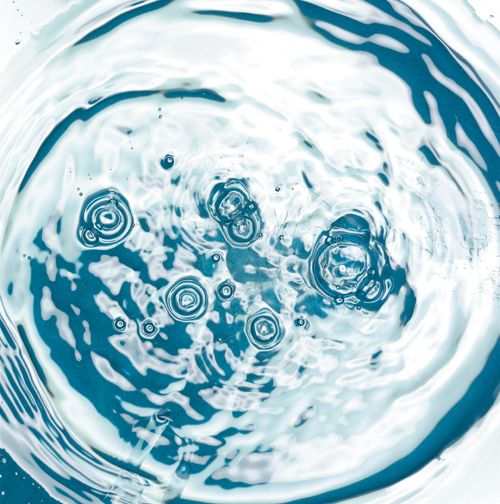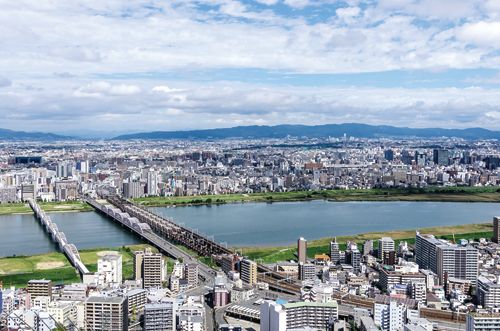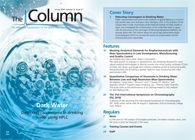Detecting Carcinogens in Drinking Water
Water contamination has come to the forefront of global debate as a result of high profile cases such as those in Flint, Michigan, USA, or the pollution of the Ganges River in India. Koji Kosaka of the National Institute of Public Health, Japan, has investigated the contamination of the Yodo River Basin in Japan, with the precursors of the carcinogen N-Nitrosodimethylamine (NDMA). He recently spoke with The Column about his use of high performance liquid chromatography (HPLC) to uncover the source of contamination and the chemical precursors responsible.
Photo Credit: Image Source/Getty Images

Water contamination has come to the forefront of global debate as a result of high profile cases such as those in Flint, Michigan, USA, or the pollution of the Ganges River in India. Koji Kosaka of the National Institute of Public Health, Japan, has investigated the contamination of the Yodo River Basin in Japan, with the precursors of the carcinogen N-Nitrosodimethylamine (NDMA). He recently spoke with The Column about his use of high performance liquid chromatography (HPLC) to uncover the source of contamination and the chemical precursors responsible. - Interview by Lewis Botcherby
Q. In 2009 your group published a study identifying anti-yellowing agents as precursors of the relatively high concentrations of N-Nitrosodimethylamine (NDMA) found in water treatment plants.1 This was occurring at water intake points in the Yodo River Basin upstream from sewage treatment plants and was caused by ozonation. What initially led your group to begin this study?
A: We were initially interested in NDMA as it is an emerging disinfection by-product in drinking water. However, reports of NDMA concentration in drinking water were limited, except for in the USA and Canada.2 So, we wanted to develop an analytical method using solid-phase extraction (SPE) with liquid chromatography coupled to tandem mass spectrometry
(LC–MS–MS) and investigate its concentration in drinking water within Japan as part of a national survey. In addition, we wanted to investigate the fate of NDMA during water purification processes. From our study,3 we found that NDMA concentration increased after ozonation at the water purification plant in the Yodo River Basin. The Yodo River Basin is located in the western part of Japan and is the second largest water supply.
When we started the survey of NDMA, it was reported that it was formed during chloramine disinfection and not during ozonation. So, we initially suspected our results were wrong, but after further studies produced the same result, we found that our results were in fact correct. During a similar research period, it was also found by a group of water utility researchers located in the Yodo River Basin that NDMA was formed during ozonation at the water purification plant.4 In addition, before our publication, a few other research groups in other countries had reported that NDMA was formed during ozonation.5,6 That is to say, although we were not the first to report that NDMA formation occurred upon ozonation, we were one of the earliest reports and certainly added to the growing body of evidence surrounding NDMA formation.
At the moment the number of cases of NDMA formation from ozonation at actual water purification plants is very limited. The only major cases were those in Germany6 and the Yodo River Basin, Japan.
Q. What is the significance of NDMA being found in high concentrations? And what exactly is ozonation?
A: Well NDMA is categorized as a Group 2A, probably carcinogenic to humans, by the International Agency for Research on Cancer.7 An NDMA concentration of 0.7 ng/L in drinking water is associated with a 10-6 increase in lifetime cancer risk by the US Environmental Protection Agency’s Integrated Risk Information System.8 The WHO guideline value for drinking water is 100 ng/L.9
Although NDMA is not selected as one of the legally binding standard items as far as we know, guideline values for NDMA in drinking water are set by several countries including Japan although the values vary between countries.
The significance of NDMA as an emerging disinfection by-product in drinking water really comes from the use of disinfection and oxidation processes (chloramination and ozonation) across many countries. Ozonation is an important process for generating clean drinking water and one of the major advanced water purification processes applied at water purification plants. Its importance as a process is not limited to just water purification; it has many purposes. One example is at wastewater treatment facilities where it is used for the disinfection, deodorization, decolorization, and decomposition of hazardous chemicals. To put the issue into context, in Japan about 20% of all finished drinking water has been treated with ozonation.
Q. What were the key findings of that study?
A: There are several sewage treatment plants in the upstream area of the Yodo River Basin. Of those treatment plants some of their effluents or influents contained the NDMA precursors, which upon ozonation would form NDMA. When we collected a sample of influent from one of the sewage treatment plants, concentrated it, fractionated it using HPLC, and ozonated the HPLC fractions, we found HPLC fractions containing NDMA precursors by analyzing NDMA concentrations in the ozonated fractions. By analyzing the fractions containing NDMA precursors with ultrahigh-pressure liquid chromatography coupled to mass spectrometry (UHPLC–MS–MS) we found two anti-yellowing agents (4,4’-hexamethylenebis(1,1-dimethylsemicarbazide) and 1,1,1’,1’-tetramethyl-4,4’-(methylene-di-p-phenylene)disemicarbazide). These were later identified as new NDMA precursors upon ozonation. The sewage treatment plant from which the two anti-yellowing agents were identified was not the main source of the NDMA precursors in the Yodo River Basin. We already understood this as a different research group had previously published results indicating the contributions of individual effluents from the sewage treatment plants to the total amount of NDMA precursors in the basin.4 However, the influent of the sewage treatment plant was used because the NDMA precursors upon ozonation were highly contained in the influent. After identification of the two anti-yellowing agents, occurrence of the compounds in a sewage treatment plant, the main source of the precursors reported by the other group,4 was investigated. The two compounds were found in the water of the sewage treatment plant. But, unfortunately, the contribution of these two compounds to the total NDMA precursors was limited. In addition, the NDMA precursors were originally contained in the influent of the sewage treatment plant.
Figure 1: The Yodo River running through Osaka, Japan. Photo Credit: Westend61/Getty Images

Q. You followed that study up with another in 2014, what was the aim of this new study?10
A: As mentioned earlier, in our previous study the two NDMA precursors upon ozonation were newly identified. However, their contributions to the total NDMA precursors in the Yodo River Basin were unfortunately not high.
Therefore, a new study was conducted and the sewage treatment plant, which was the main source of the NDMA precursors in the Yodo River Basin, was targeted. The objectives of the new study were to find the main source of NDMA precursors upon ozonation flowing into the sewage treatment plant, and to identify the main NDMA precursors upon ozonation in the basin.
Q. What were the key findings of this study?
A: We collected the sewage from the pipes connected to the sewage treatment plant, which was the main source of the NDMA precursors in the Yodo River Basin. When we analyzed the NDMA concentration in the sewage before and after ozonation, it was found that the main source of NDMA precursors in the Yodo River Basin was effluent from that chemical facility. The effluent from the chemical facility was being flowed into the sewage and discharged into the Yodo River Basin via the sewage treatment plant. Using a procedure similar to our first study in 2009 we found 1,1,5,5-tetramethylcarbohydrazide (TMCH) and identified it as a new NDMA precursor. The molar formation yield of NDMA upon ozonation from TMCH was much higher than those from the NDMA precursors previously reported.
We later found that TMCH is used as an agent for anti-deterioration, and confirmed that TMCH was the main NDMA precursor upon ozonation in the Yodo River Basin.
Q. How did you identify unknown compounds from the samples?
A: To identify unknown compounds from our samples we used UHPLC–MS–MS. The total ion chromatogram (TIC) from UHPLC–MS analysis presented many peaks as a result of a large number of compounds within the concentrated sewage fractions.
It was difficult to find unknown target compounds from the sample although a basic structure of the NDMA precursor (that is, dimethylamino functional group and a nitrogen neighbouring the functional group) was presumed.
In the 2009 study, the molecular weights of the compounds were initially presumed from the m/z of the peaks. The compounds with the structures considered as NDMA precursors were searched using a database of compounds. Fortuitously, such compounds were found at an early period. The compounds were commercially available, so the comparison of retention time and MS–MS spectrum between the authentic compounds and peak of the samples, allowed the identification of the compounds contained within the fractions.
However, in the 2014 study, the identification of TMCH was very time consuming. We could not find the compound from the TIC of UHPLC–MS. Therefore the concentrated HPLC fractions of the concentrated sewage containing the NDMA precursor was further fractionated using UHPLC and the retention time of the NDMA precursor of UHPLC was presumed. Using this information, the precursor was presumed by molecular formula from accurate mass (UHPLC–TOFâMS) and chemical database comparison. The candidate precursor was not commercially available, so the compound was synthesized. The compound was identified from the comparison of retention time, MS–MS spectrum, accurate mass, and nuclear magnetic resonance (NMR) between authentic compound and peak of the sample.
Q. What actions have occurred to rectify the problem following the publication of your research?
A: Since the release of our studies NDMA has been selected as one of the compounds in a list of items for further study in drinking water regulation within Japan, and the guideline value of NDMA has been set at 100 ng/L.
The information on NDMA formation upon ozonation was delivered to the staff at the divisions of water and wastewater in the Yodo River Basin. Now NDMA is regularly monitored for at water purification plants by some water utilities.
Further investigations have shown that the NDMA formation in water purification plants on the Yodo River Basin has gradually decreased since 2011.10 Currently, the NDMA formation upon ozonation at the water purification plants is very low.
Q. What are you currently working on?
A: After finding TMCH, we investigated the occurrence of TMCH in environmental water and effluents in the Yodo River Basin and in raw water throughout Japan.11 It was found that TMCH was found only in water affected by the effluent from the sewage treatment plant on the Yodo River Basin. Once again this points to the sewage treatment plant as the main source of TMCH. In addition, we investigated TMCH treatment during water purification processes to facilitate the removal of TMCH from drinking water supplies.12
Finally, we have also investigated other types of emerging disinfection by-products involving a chlorinous odour compound.13
References
- K. Kosaka et al., Environ. Sci. Technol.43(14), 5236–5241 (2009).
- W. Mitch et al., Environ. Eng. Sci.20, 389–404 (2003).
- M. Asami et al., Sci. Total Environ.407, 3540–3545 (2009).
- H. Tateishi et al., Journal of Japan Water Works Association895, 8–22 (2009) (in Japanese).
- P. Andrzejewski et al., Water Res. 42, 863–870 (2008).
- C.K. Schmidt et al., Environ. Sci. Technol.42, 6340–6346 (2008).
- The International Agency for Research on Cancer http://monographs.iarc.fr/ENG/Classification/latest_classif.php
- US Environmental Protection Agency’s Integrated Risk Information System https://cfpub.epa.gov/ncea/iris/iris_documents/documents/subst/0045_summary.pdf
- WHO Guidelines for drinking-water quality http://www.who.int/water_sanitation_health/publications/dwq-guidelines-4/en/
- K. Kosaka et al., Environ. Sci. Technol.48, 11243–11250 (2014).
- K. Kosaka et al., Anal. Sci.31, 769–772 (2015).
- T. Iwamoto et al., Proceedings of Research Conference of Japan Water Works Association in fiscal year 2014, 548–549 (2014) (in Japanese).
- K. Kosaka et al., Water Sci. Technol.: Water Supply14, 650–656 (2014).
Koji Kosaka is a senior researcher at the National Institute of Public Health, Japan. He investigates the development of analytical methods of hazardous chemicals involving disinfection by-products and their precursors in water using liquid or ion chromatography coupled to tandem mass spectrometry (LC or IC–MS–MS) and gas chromatography (GC) coupled to MS and their occurrence in the water supply system. He identifies the contamination sources of target chemicals such as perchlorate and NDMA, and the causative chemicals of the contamination. He also investigates the treatment technologies of the target chemicals, with a particular focus on ozonation. He graduated with a bachelor’s degree and a master’s degree in engineering from Kyoto University, Japan, in 1997 and 1999, respectively, and later earned his doctorate in engineering from Kyoto University, Japan, in 2002.

New Method Explored for the Detection of CECs in Crops Irrigated with Contaminated Water
April 30th 2025This new study presents a validated QuEChERS–LC-MS/MS method for detecting eight persistent, mobile, and toxic substances in escarole, tomatoes, and tomato leaves irrigated with contaminated water.
University of Tasmania Researchers Explore Haloacetic Acid Determiniation in Water with capLC–MS
April 29th 2025Haloacetic acid detection has become important when analyzing drinking and swimming pool water. University of Tasmania researchers have begun applying capillary liquid chromatography as a means of detecting these substances.

.png&w=3840&q=75)

.png&w=3840&q=75)



.png&w=3840&q=75)



.png&w=3840&q=75)








